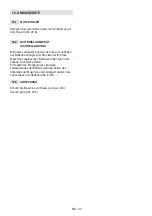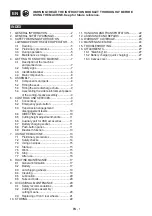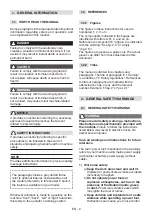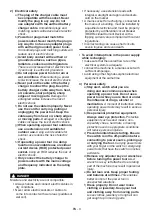
EN - 3
2) Electrical safety
a)
The plug of the charger cable must
be compatible with the socket. Never
modify the plug in any way. Do not
use adapters with the earthed battery
charger cable.
Unmodified plugs and
matching outlets will reduce risk of electric
shock.
b)
Power tool plugs must match the
power socket. Never modify the plug in
any way. Do not use any adapter plugs
with earthed (grounded) power tools.
Unmodified plugs and matching outlets will
reduce risk of electric shock.
c)
Avoid body contact with earthed or
grounded surfaces, such as pipes,
radiators, cookers and refrigerators.
There is an increased risk of electric shock
if your body is earthed or grounded.
d)
Do not expose power tools to rain or
wet conditions.
Water entering a power
tool will increase the risk of electric shock.
e)
Never pull on the cable of the battery
charger to extract the plug. Keep the
battery charger cable away from heat,
oil, solvents, sharp objects, sharp
edges or moving parts.
Damaged or
entangled cables increase the risk of
electric shock.
f)
Do not use the cable improperly. Never
use the cord for carrying, pulling or
unplugging the power tool. Keep the
cable away from heat, oil, sharp edges
or moving parts.
Damaged or entangled
cables increase the risk of electric shock.
g)
When operating a power tool outdoors,
use an extension cord suitable for
outdoor use.
Using a cord suitable for
outdoor use reduces the risk of electric
shock.
h)
If operating a power tool in a damp
location is unavoidable use a residual
current device (RCD) protected power
socket.
Using an RCD reduces the risk of
electric shock.
i)
Only connect the battery charger to
power sockets with the mains voltage
and frequency indicated on the rating
plate.
DANGER
Moisture and electricity are not compatible:
•
Always handle and connect electric cables in
dry conditions.
•
Never allow electric sockets or cables to
come into contact with wet areas (puddles or
wet soil).
•
If necessary, use extension leads with
integral, watertight and approved sockets
sold on the market.
•
A mains socket for recharging, connected to
the mains of a building, must be installed by
a qualified electrician and must be properly
protected by a differential circuit breaker
(RCD Residual Current Device) with a
tripping current value compliant with current
regulations.
•
Incorrect wiring can cause short circuits,
severe injuries and even death.
•
To avoid interruptions in the power supply
while recharging:
•
make sure that the overall flow rate of the
electrical system is adequate.
•
connect the machine to a mains socket with
sufficient amperage.
•
avoid using other high absorption electrical
equipment at the same time.
3) Personal safety
a)
Stay alert, watch what you are
doing and use common sense when
operating a power tool. Do not use a
power tool while you are tired or under
the influence of drugs, alcohol or
medication.
A moment of inattention while
operating power tools may result in serious
personal injury.
b)
Use personal protective equipment.
Always wear eye protection.
Protective
equipment such as dust masks, non-
slip safety shoes, hard hats, or hearing
protection used in appropriate conditions
will reduce personal injuries.
c)
Prevent unintentional starting. Ensure
the switch is in the off-position before
connecting to power source, picking up
or carrying the tool.
Carrying power tools
with your finger on the switch or energising
power tools that have the switch on invites
accidents.
d)
Remove any adjuster keys or wrenches
before turning the power tool on.
A
wrench or a key left attached to a rotating
part of the machine
may result in personal
injury.
e)
Do not lean over.
Keep proper footing
and balance at all times.
This enables
better control of the power tool in
unexpected situations.
f)
Dress properly. Do not wear loose
clothing or jewellery. Keep your hair
and clothing away from moving parts.
Loose clothes, jewellery or long hair can
get caught up in moving parts.
Summary of Contents for AM 108 Li 48 V2
Page 3: ... Ah battery capacity Nominal voltage min s n kg Type Art N V 9 5 10 1 11 2 8 3 6 12 4 7 1 2 3 ...
Page 4: ...B 2 A C B 2 A D C B D 1 E D E 1 A B B 1 B B 4 5 6 7 ...
Page 5: ... 8 9 I II ...
Page 6: ...10 12 14 16 max 15 27 1 3 11 13 15 ...
Page 7: ... D C B A TEST BEFORE USE TEST RESET 17 18 19 20 21 A H H 30 mm H 10 mm H 20 mm H 0 mm ...
Page 8: ... 22 23 24 25 A B 26 ...
Page 9: ... 27 28 29 ...
Page 414: ......
















































